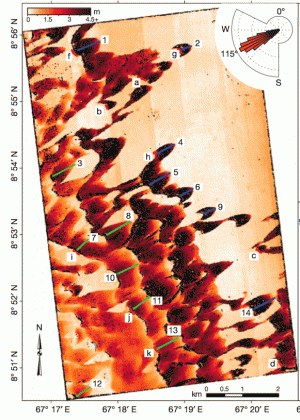Scientists have known for years that Martian sand dunes and ripples move as wind blows over them. But for the most part they thought the motion was small because the atmosphere is thin and high-speed winds are rare.

CREEPING SANDS. HiRISE images from 2007 and 2010 let scientists measure the motion of sand ripples and dunes in Nili Patera. The results indicate that for Nili at least, the sand movements are comparable to dune movements on Earth. The wind-rose at upper right shows prevailing winds blow from the northeast, driving the dunes to the southwest. (Image taken from Figure 1 in the paper.)
Now new research using before-and-after images taken by the HiRISE camera on NASA’s Mars Reconnaissance Orbiter shows that the amount of sand movement in one place at least is comparable to what’s seen on Earth. These reveal that entire dunes as much as 60 meters (200 feet) thick have moved as a unit.
After studying the dune field in Nili Patera, Nathan Bridges (Johns Hopkins University Applied Physics Laboratory) and colleagues write in Nature that, “The dunes are near steady state, with their entire volumes composed of mobile sand.” The images were taken in 2007 and 2010.
“We chose Nili Patera because we knew there was sand motion going on there, and we could quantify it,” says Bridges. “The Nili dunes also are similar to dunes in places like Antarctica and to other locations on Mars.”
The movement of sand ripples amounted to as much as 4.5 meters (about 15 feet). The scientists also noted that ripples moved faster as they rose up the wind-facing side of the dunes. By correlating ripples’ movement to their position on the dune, the analysis determined the entire dunes are moving. This let the scientists estimate the volume, or flux, of moving sand.
How much did they move? The team calculates that if you stood in the Nili Patera dunes and measured across a one-yard width, you would see more than two cubic yards of sand, about as much as in a child’s sandbox, pass by during an Earth year.
This conflicts with previous views, says the team. “One view of Mars has been that conditions since the end of the Hesperian period, 1.8 billion years ago, have been fairly static, with very low erosion rates. This study shows that this is not the case at Nili Patera, and probably not at other areas of Mars where there are significant gusts of sand and wind.”
Yet the new results help explain a geological puzzle, they say. “Vast areas of the Martian surface show evidence of erosion and removal, including of mantle materials for which the processes and agents of exhumation have been a mystery — yet these places also contain fields of large dunes that migrate at relatively slow rates.
“Over long time periods, it may be that much or all of Mars has been subjected to large sand fluxes, with associated erosional modification of the landscape.”
Says Bridges, “No one had estimates of this flux before. We had seen with HiRISE that there was dune motion, but it was an open question how much sand could be moving. Now we can answer that.”








